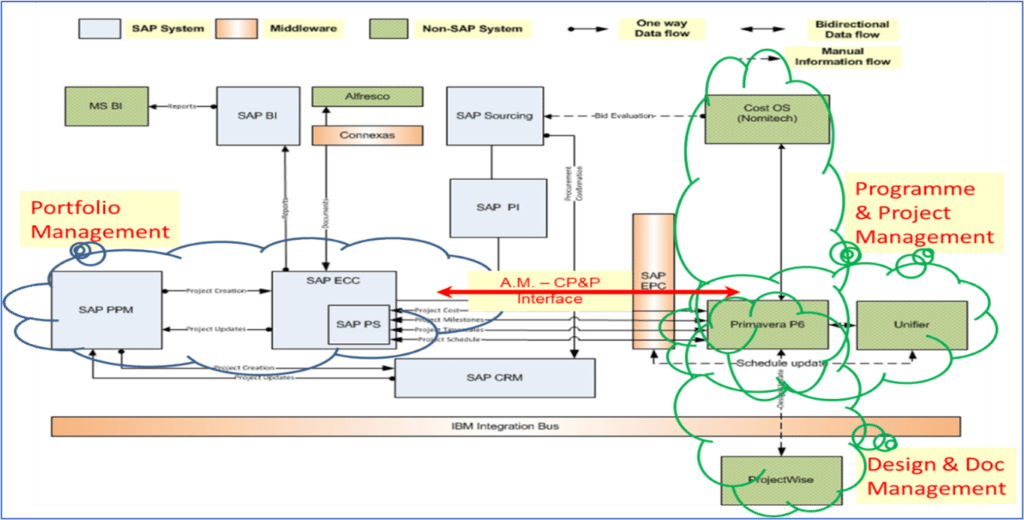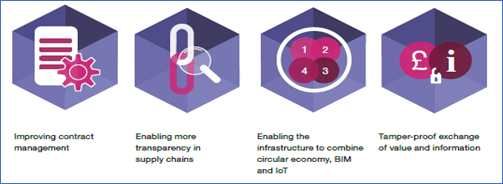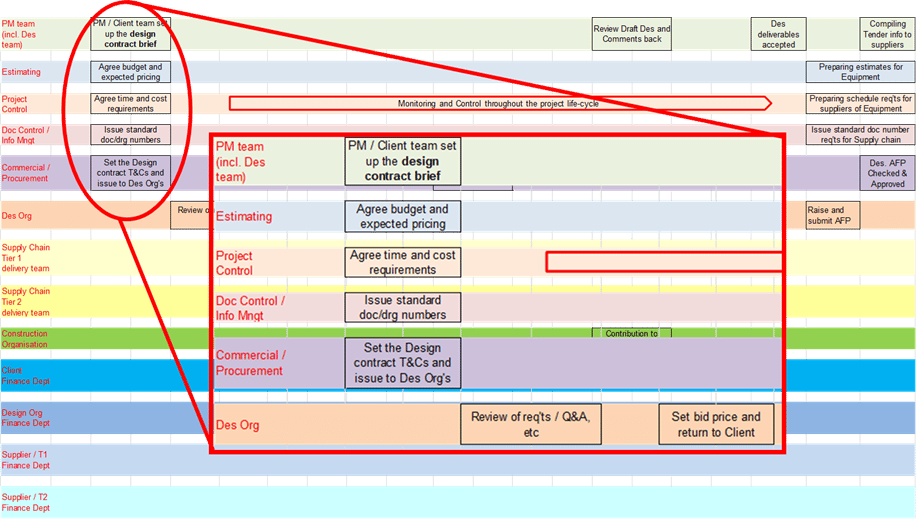You may have heard about blockchain and how it enables digital currencies. But Blockchain Project Control?
Is that even possible? Does blockchain even belong to Project Controls?
If you would like answers to the questions above, then look no further and read the blog post below. You’ll explore how Blockchain Project Control can help improve the delivery of your projects.
See how I worked together with organizations to implement a Blockchain Project Control proof-of-concept (POC) and how much the estimated tangible benefits came to be.
As you know, integration, accuracy, transparency, speed of transfer and trustworthiness of project data is very important for projects and key to decision making. It is only very recently that current technologies started accommodating one or maybe two of these requirements.
On the other hand, blockchain technology, which provides security, trustworthiness, transparency and irreversibility, is progressing rapidly in a number of industries, like banking, insurance, shipping, etc. Blockchain drives operational efficiencies by removing intermediaries, minimizing time and effort spent on admin, record keeping and transaction reconciliation.
Many of the technology characteristics could be used to support the management and delivery of projects and therefore project control. Combined with other initiatives, such as storage of design / drawings on the cloud, common data environment, smart contracts, collaborative working, standard project management structures, etc., it can support the efficient delivery of projects and generally Project, Program and Portfolio Management (P3M).
With material from two cases studies, I will present the benefits, challenges, implementation requirements and how the technology can be used to improve project monitoring and control processes and the delivery of projects / programs.
1. Making Up for Lost Time Through Blockchain Project Control
The human race’s movement through the ‘ages’ – stone, bronze, …, 3rd Industrial Revolution (IR) and now in the 4th IR (4IR), was not because of any lack of materials but rather because humans evolved, innovated, progressed and developed new technologies. In fact, we know that this progression is happening at a much faster pace in 4IR. Moore’s Law (Moore, 1975) stated that the number of transistors on a microchip doubles every two years (exponential increase – 2n). However, this has now been superseded with Neven’s Law, which states that the growth in power is increasing at a double-exponential rate (2(2n)) (Yoshida, 2019).
Technological achievements now move much faster and a number of industries are now playing catch-up. In project delivery and in particular construction projects, implementation of technology is even slower; due to certain requirements, financial (levels of margins, etc), biases (Flyvbjerg, 2021) and managing the effects of complexity (Antoniadis, 2020). Several of the points I discuss in this paper were developed decades ago and some others in the last few years.
In addition to managing the technological changes that are ‘trickling’ through to the project profession the project world is changing and we as professionals have to deal with not only large-scale projects but also a large number of medium to small projects. Taking this into consideration, a professional could be looking at a significant number of projects to handle as Project Manager (PM) or Project Controller (PC). Therefore, we need to streamline processes and technology to enable PMs and PCs to successfully deliver projects.
Considering the above and using two case studies I will demonstrate the challenges, how these can be managed and how blockchain, as one of the latest technologies, can be used advantageously by project professionals.
Using the first case study, I will present how a major transformation program, which he co-led for the Capital Programme and Procurement (CPP) Directorate for a major Utilities organisation, integrated data and software tools which served not only the organisation but also the four alliance partners. I will go on to present the challenges, not only of the transformation program but also of the general environment, together with the integration of all the project control software tools. Thirdly, the paper will cover the basics of blockchain, leading on to the second case study with the implementation of blockchain and the Proof of Concept (PoC) project. I contributed extensively to the set up and will demonstrate the requirements and how the technology can be used in construction project management / control.
2. Transformation – The Case Study Paving The Way For Blockchain Project Control
The first case study involves a major transformation program in a power utilities organisation. In order to put this into context, I will briefly describe the ‘environment’ with its challenges – external and internal. We will then look at the approach to delivering the project control relevant part of the transformation program.
2.1. The Environment and The Need
The major power utilities organization covers three geographical locations serving 19M people. As all utility organizations in UK, it is regulated by Ofgem and their eight-year program of works, outputs, level of services, etc. is approved by the regulator before commencement of the works. In addition to the regulated program of work the organization also has a non-regulated program of works serving directly clients, such as building developers, solar and wind power farms, etc.
The size of annual expenditure, on the capital program side, is in the hundreds of millions of GBP (£) and more importantly the number of projects per annum for the regulated and non-regulated sides is also in the hundreds with Project Managers (PM) managing between 10 to 15 projects each and Project Controllers (PC) supporting a similar number of projects. (Due to confidentiality issues values cannot be disclosed). Therefore, the level of requirements was very high.
The work was delivered by nine program managers, a PMO, which included the project control department, and all other relevant departments (e.g., Supply chain, Commercial, etc.). The organization had established an alliance with four power construction organizations who covered all the geographical locations and there were a number of other commercial contracts with suppliers, etc. So, the whole setting involved many interconnections, not only internal (inter-directorate) ones but also with the four alliance organizations and other suppliers at various tiers.
The ‘environment’ in collaborative working is challenging, as has been described widely in project management literature. We are looking at socio-organizational systems (Antoniadis, et al., 2010) that come together to deliver various parties’ long-term strategic objectives through a number of programs of work and at the same time serve their own ‘purpose of existence’. In addition to the obvious interconnections, there are also hidden interconnections between and within the ‘systems’ that need to come together and form collaborative environments.
With this background and to address the large number of challenges the Board decided to embark on a major transformation program, which will be described in more detail in section 2.3.
However, first we need to look at the challenges project practitioners are facing in general as well as in the case of the transformation program.
2.2. The Challenges
Project environments are Volatile, Uncertain, Complex and Ambiguous (VUCA) and project management institutions like the PMI, APM and IPMA aim to address and support practitioners through various initiatives. APM in UK has launched one such initiative which is called ‘Projecting the Future’.
2.2.1. The Generic Challenges
In one of a series of APM (2019 & 2020) articles on ‘projecting the future’ they demonstrate the challenges practitioners will face in the near future due to technology. Fig. 1 below demonstrates some of the very interesting numbers.

Figure 1: The Generic Challenges – APM Projecting The Future Report (APM, 2019 & 2020)
Therefore, we should anticipate and be prepared for these changes and not only from Artificial Intelligence (AI), Machine Learning (ML), etc.
2.2.2. Challenges In The Case Study
From the case study side, I described some of the company-wide challenges earlier. The PMO/Project Control side needed to address both the company-wide challenges alongside managing the overall review of the project management / project control processes and systems. Therefore, there was a need to address:
- Drivers for significant efficiency and innovation,
- Improvement in quality and service,
- The difficult competitive landscape,
- Skills shortage and appropriate level of resource management,
- Collaborative working and management on the internal as well as external interfaces,
- Geographical program of works diversity,
- Varying work practices within the company and the partners,
- Rolling out a set of common integrated project management software tools which will link up to the ERP company-wide software tool.
2.3. The Initial Approach To The Transformation Program (Without Utilizing Blockchain Project Control)
As an initial step towards the major transformation program I, together with other Senior Management team members, redrafted and communicated widely the asset management project lifecycle, see Fig. 2 below.

Figure 2: The Asset Management Lifecycle And Program / Project Delivery (Courtesy Of UKPN)
This set up a common base not only for the Directorate but also for all the other internal and external parties.
Following on from that, the team set up the standard project management structures (WBS, OBS, CBS, etc.) and linked these up to the Asset Management Plan. The structures not only ensured the linking of data through the different software tools but also enabled the alliance partners to map their level of operations.
The team redrafted, reviewed widely and communicated processes and procedures from the lowest to the highest level – project to program and portfolio levels (to accommodate interlinks and use of the software tools).
Fig. 3 provides an indication of how the scheduling, cost / contract management and estimating software tools were integrated. A software tool served all project control processes which minimised duplication of effort and the use of ‘grey-IT’ (as in unconnected software packages, usually Excel). Implementing a number of ‘set ups’ meant the system was future-proofed to accommodate further developments, such as Building Information Modelling (BIM), ML for reporting through Analytics and as in the case of this paper, blockchain.

Figure 3: Integrated Program & Project Management System Future-Proofed For Blockchain Project Control
In parallel with the development on the processes within the project control software tools, and with the transformation program team, work took place to ensure the interfaces between the delivery tools and the ERP software were viable and working. Fig. 4 gives a pictorial view of the company-wide ERP system and how the delivery side interfaced with the asset management side.

Figure 4: Transformation Delivery – Interfaces Diagram (Future-Proofed For Blockchain Project Control)
The transformation program was delivered on time and all the CPP processes delivered the required integration of data between all the parties.
Unavoidable challenges were overcome through perseverance from staff at all levels – from the lowest to the most senior, with communication, training and other means.
However, the speed of transactions, movement and validation of data (from hard copies to soft data, e.g., application for payment), approvals, etc. took their conventional time to be completed despite the integration of software tools.
That is the reason I, together with a group of other individuals working for organizations such as Nomitech, IBM, SAP, ARUP, TATA Steel, HS2, WOOD Group, Network Rail, CISCO, and others, formed a group and investigated the use of blockchain in the delivery of projects. The main aim was to investigate the viability, design the case study and then proceed with a Proof of Concept (PoC) rather than deliver a feasibility report / theoretical output.
However, before we proceed with the case study of the PoC we need to look at some basics regarding blockchain.
3. What is Blockchain Project Controls?
Blockchain technology, in addition to the widely known use in Bitcoin / digital money, is considered by some authors e.g., Beck (2018) as important as the internet.
In the project world, when blockchain is combined with other technologies such as for example ‘smart contracts’ (Christidis & Devetsikiotis, 2016) it creates what academic papers refer to as blockchain economy (Beck & Müller-Bloch, 2017; Beck, et al., 2018).
Let us look in high level at the theory of blockchain.
3.1. The Theory of Blockchain
In simple terms, blockchains are networks of nodes (blocks) that communicate securely with each other, allow for the transaction of data and ensure that parties in the chain are synchronised and hold / see the same data.
It started as a means of transferring digital moneys over the internet, outside financial institutions, but now has expanded to include other type of data and serving a number of industries.
It is a secure, trustworthy, transparent and irreversible way of transmitting data over the internet.
Individual blocks contain data that are time and date stamped, placing them in sequence. Cryptography ensures that the blocks / data cannot be copied, or other data be inserted and break the history of the chain. So now you can understand why blockchain is famously illustrated as interlinked blocks such as in Fig. 5 below.

Figure 5: Like The Illustration, Blockchain Project Control Promises Security and Continuity
Blocks have their own unique signature. Each block validates independently all other blocks within the blockchain and when stored creates a ledger. (Blockchain is also referred to as Distributed Ledger Technology (DLT)). The blockchain is completely transparent and gives the full history of the data users are working with.
Blockchain is a decentralized database which transfers securely and records by means of time stamp transactions. Transactions, as in cryptocurrency (like Bitcoin and therefore its architecture) can represent the transfer of value on systems such as Ethereum. For projects this could mean an efficient, easy way of sharing items such as contract for approval (see Smart Contracts), application for payment for approval, invoices, reports, or design/drawings, etc. In fact, blockchain has the potential to significantly improve project management / monitoring and control more widely since it can deliver so many of these requirements e.g., transparency, ease of transfer, full data history.
Focusing on the types of the blockchain transactions and the systems within which these can ‘operate’, we have two types of transactions “Public” and “Private”.
Within these two types we have different levels of transaction validation permissions, and in terms of project and project control this is where companies – networks of – will have to decide which approach to take.
Within a ‘Public’ set up we have:
- Transaction validation with permissions, where all nodes/’participants’ can read and submit, but only authorized nodes can validate.
- Transaction validation without permission, where everyone can read, submit and validate. An open environment.
Within the ‘Private’ set up we can only have transaction validation with permissions, where only authorized nodes/’participants’ can read, submit and validate.
In the case study and the proof of concept (PoC) that will be presented in section 3.2 we considered the latter – ‘Private’ set up – with, therefore, only authorized participants being able to read, submit and validate.
The quotes below, from two separate reports emphasize even further how blockchain technology can support the delivery of projects, including construction.
Raughs, et al., (2019): A Blockchain or Distributed Ledger Technology (DLT) system needs to be capable of ensuring the following four properties (as in Fig. 6 below):

Figure 6: Key Benefits Of Blockchain Project Control For The Built Environment (Figure 6, ARUP, 2019)
- Shared record-keeping: enable multiple separate entities to provide data inputs and participate in the creation of new records.
- Multi-party consensus: require multiple separate entities to collectively reach agreement over the ordering of transactions in the absence of a central authority.
- Independent validation: enable each participant to independently verify the state of their transactions and the integrity of the system. This also involves detecting unauthorised changes applied to records in a trivial way.
- Tamper evidence: allow each participant to detect on-consensual changes applied to records trivially.
- Tamper resistance: make it hard for a single party to unilaterally change past records (i.e., transaction history).
It is worth noting that DLT systems are dynamic and constantly evolving.
The ARUP report on Blockchain Technology (ARUP, 2017) states: Blockchain could help turn around stagnating output in construction, relative to employment, by improving contract management, enabling more transparency in supply chains, and providing the technological backbone needed to combine aspects of the Circular Economy, BIM, IoT systems and smart sensors. It adds a new layer on top of internet infrastructure for the tamper-proof exchange of value and information.
3.1.1. Benefits And Initiative Drivers for Blockchain Project Control
Reflecting on the above, some key benefits and initiative drivers for Blockchain Project Controls are common standards, automated workflow, adopting good practice throughout the program delivery, use of Common Data Environment – enabling BIM, Use of ‘smart contract’, drives operational efficiencies, removing intermediaries, and reducing admin effort and reconciliation of transactions.
Flyvbjerg (2021) states that speed and modularity in mega projects is important. I would also add that speed is important in all projects, especially when we are dealing with high volumes.
3.2. Blockchain Project Control - Case Study
Between the period of 2017 and 2020, under the chairmanship of Mr. Ahmed Zghari, the team explored the requirements for implementing blockchain in delivery of construction projects.
Focusing, for the purpose of this paper and the Project Control Summit, purely on the project control requirements I will provide high level of details of these requirements, which are also based on the efforts and lessons learnt from the transformation program described earlier.
All team members agreed on the importance of structuring data and how these are circulating between the different parties of a project. This was the case in the transformation program as well as what needed to be followed in the PoC. Standard project management structures not only provide the ability for rolling up of data from project to program and portfolio levels but also an efficient delivery and transfer of data between parties in a structured approach. Therefore, the coding of these structures, as well as other relevant coding, can and should become an identifier in a blockchain ‘block’. Coding of data was considered in the wider case, as in not only coding of activities, etc., but also drawing numbers, raising of order(s), control account coding, invoices, etc.
As mentioned earlier, with current systems, data communication and transfer is not as efficient and effective as that of the Blockchain and additionally (in many cases) introduces an increased level of administrative tasks.
Having set up the structures and data coding to be used to set up the PoC, the team considered and implemented a full cycle process for the design approval, placement of orders (through various organizations) and delivery of a building facia panel. The steps below indicate the approach taken:
➡️ Step 1- The design organization submits the drawing for the building panel to the client for approval,
➡️ Step 2- The client reviews and accepts the design organization’s drawing,
➡️ Step 3- The client places an order for the delivery of the panel to the main contractor,
➡️ Step 4- The main contractor raises an order to the building contractor,
➡️ Step 5- The building contractor places an order to the steel manufacturer of the panel,
➡️ Step 6- Steel manufacturer completes the panel and all relevant data are stored in their database,
➡️ Step 7- Upon completion the steel manufacturer places an order to the haulier who will deliver the panel on site,
➡️ Step 8- Haulier delivers the panel on site,
➡️ Step 9- Panel is checked against the requirements and accepted by the building contractor.
➡️ Step 10- PoC closes and team evaluates speed of approvals, process, etc.
It should be noted that at each step, in addition to the transmission of the relevant data, the required validation and authorisation was carried out.
Fig. 7 below is an illustrative example of the PoC and blockchain steps.

Figure 7: Illustrative Proof Of Concept For Blockchain Project Control Pilot Process Flow
The process steps and the PoC was presented at client Senior Management levels with detailed description of value delivered at each step and the business benefits. Following further discussions, the team, as well as other parties, including the client, estimated that the implementation of blockchain could deliver a 2%-4% Tangible Benefit on Construction Project Costs.
Fig. 8 below shows how using the swim-lane approach helped set up the process steps.

Figure 8: Swim-lane Process Flow Used To Set Up The Blockchain Project Control Case Study
In the following section I will describe the approach and the requirements for implementing blockchain from the project control side in more detail.
4. The Approach and Requirements For Blockchain Project Control
To enable the implementation of blockchain Project Control technology we need to:
- Consider the whole picture early – having a holistic system view.
- Accept that the project delivers an asset and therefore belongs to a hierarchy – the client asset management hierarchy. Therefore, work with the client to incorporate the asset management hierarchy in the project coding.
- Understand the standard project management structures.
- Understand how the structures interface and in many cases how to interlink these – especially Work & Cost Breakdown.
- Standardise and use asset and project management structures throughout the project parties.
- Position the structures in a standard ledger.
- Use of Common Data Environment (CDE) which in addition to digital drawings will also hold project documentation in a standard structure.
- Digitisation of drawings and therefore BIM.
- Set up how the technology can and should support authorisation and validation of data.
- Accept that other functions need to receive accurate data from interconnected software tools. Therefore, minimise the use of grey IT.
- Management of behaviours.
- Management of the change.
- Build trust and collaboration – not just the relationship plan.
In terms of additional requirements / contributions from the blockchain side to P3M and control, the technology / software used, as well as the organisations, need to:
- With the appropriate parties, support the decision-making process of selecting the blockchain ‘type of transaction’ and the ‘validation permission’ processes.
- Incorporate all common structures / standards,
- Enable ‘smart contracts’, and therefore streamline commercial processes, and procurement / supply chain
- Enable digitisation of assets / Asset Management,
- Enable CDE and therefore improved Design Management and BIM,
- Streamline Monitoring and Control processes,
- Through ML ease of reporting.
Several points raised above are very closely linked to governance, assurance as well as some other fundamental project management / control processes. Therefore, the PMO department will be ideal to oversee the flow and that timely authorisation from the appropriate role is carried out.
5. What Has Changed To Incentivize People To Use Blockchain Project Control
To secure the most benefit from using blockchain Project Control and for it to have an impact, it must be implemented on a wide scale across organizations. Blockchain has created a catalyst for this change because it offers: the structuring of the data, the automated workflow, the transparency derived from the blockchain and the various other developments, e.g., legal smart contract, cloud technology, etc.
Another catalyst is that all designs now have to be digitally stored in the cloud to prevent loss of crucial documents as well as enable BIM.
Generally, there is a central directive to follow process, but needs something to enforce adherence to these and the contracts. This does not exist at the moment.
Supply chains on big projects are international.
Implementing blockchain has become a global target and as stated earlier, at least in the case of UK, the Government is supporting such initiatives. Additionally, we see consultancies, such as McKinsey (2018), point to the fact that there is need to ‘drive operational efficiencies, … removing intermediaries or admin effort of record keeping and transaction reconciliation’ and blockchain is one of those technologies.
6. Final Thoughts on Blockchain Project Control
Having participated in both case studies, I consider blockchain to be the ideal technology to implement in support of the project delivery. Efficiencies in data capture, transfer and the efficient and effective processing will deliver considerable business benefits and savings. However, there are still technical issues to be overcome. One of the fundamental ones is deciding within which system the technology should operate – public or private. There are also the issues with speed, however, as technology improves it is expected that it will become less of an issue.
At Project Control Academy, we are always excited about new, emerging, and disruptive technologies. So congratulations, today you expanded your knowledge horizon with blockchain project control!
But hold up just yet! Before you wade off into the thrilling unknown, we want you to know how important it is to have a firm foundation. Yes, we mean having a strong ‘Project Controls’ foundation.
If this is you, join us in our upcoming Applied Project Controls training course. Our comprehensive course is specially designed to guide you through the basics of Project Controls and more.
Remember, every single expert started as a student. So we hope to see you soon, partner-in-training!
References:
[ 1] Antoniadis, D., Edum-Fotwe, F. T. & Thorpe, A. (2010). A Framework for the Management of Complexity in Projects. International Journal of Construction Project Management (IJCPM). Vol.3(1)
[2] Antoniadis, D., Edum-Fotwe, F. T. & Thorpe, A. (2011). Socio-organo Complexity and Project Performance. International Journal of Project Management (IJPM). 29(7)
[3] Antoniadis, D. (2020). Socio-organo Complexity, Project Schedule Performance, and Underdamped Transient Motion. International Journal of Chaos, Control, Modelling and Simulations (IJCCMS) 9(4).
[3] APM (2019 & 2020). APM Report Projecting the Future – 4IR & PM4.0. (Accessed 31Mar22).
[4] ARUP (2017). Blockchain Technology. How the Inventions behind Bitcoin are Enabling a Network of Trust for the Built Environment. ARUP Consultancy. www.arup.com
[5] ARUP (2019). Blockchain and the Built Environment. ARUP Consultancy. www.arup.com
[6] Beck, R. (2018). Beyond bitcoin: The rise of blockchain. Computer, 51(2), 54–58.
[7] Beck, R., & Müller-Bloch, C. (2017). Blockchain as radical innovation: A framework for engaging with distributed ledgers as incumbent organization. Paper presented at the 50th Hawaii International Conference on System Sciences, Waikoloa, Hawaii, U.S.A.
[8] Beck, R., Müller-Bloch, C. & King, J.L., (2018). Governance in the Blockchain Economy: A Framework and Research Agenda. Journal of the Association for Information Systems 19(10), 1020-1034
[9] Christidis, K., & Devetsikiotis, M. (2016). Blockchains and smart contracts for the internet of things. IEEE Access, 4, 2292–2303.
[10] Flyvbjerg, B (2021). Top Ten Behavioral Biases in Project Management: An Overview. Project Management Journal Vol 52(6) 531 – 546.
[11] Flyvbjerg, B (2021). Make Mega Projects More Modular. Harvard Business Review November–December 2021.
[12] McKinsey & Co. (2018). Blockchain beyond the hype: What is the strategic business value. (Accessed 31Mar22)
[13] Moore, G. (1965 & 1975). Moore’s Law. (Accessed: 31Mar22)
[14] Rauchs, M., Blandin, A., Bear, K., McKeon, S. (2019). 2nd Global Enterprise Blockchain Benchmarking Study. Cambridge Centre for Alternative Finance. University of Cambridge Judge Business School.
[15] Tapscott, D., & Tapscott, A. (2016). The impact of the blockchain goes beyond financial services. Harvard Business Review. (Accessed: 31Mar22)
[16] UK Gov (2018). UK Government policy paper: Government response to Data for the Public Good. (Accessed, 31Mar22).
[17] Yoshida, H. (2019) Moore’s Law is replaced by Neven’s Law for Quantum Computing. (Accessed: 31Mar22)
About The Author, Dr Dimitris Antoniadis

He is currently holding two Directorships in the Program, Project Management and PMO with Danton Progm and Proc Global. He is a technical advisor to Novacept and a Senior Lecturer of the BSc Degrees in Project Management and Project Control for London Metropolitan College. He has set up the B.Sc. Degree in Project Control and supported the College taking it through the approval processes.
Parts of his work can be seen in www.danton-progm.co.uk





![[Free 90-min Masterclass] The Ultimate Leadership Recipe for Project Professionals](https://www.projectcontrolacademy.com/wp-content/uploads/2024/08/4-1024x576.jpg)















